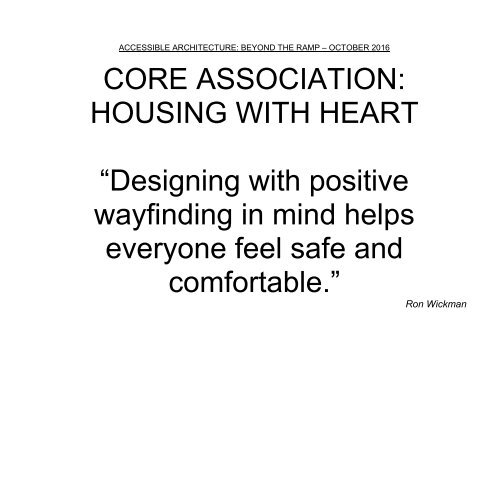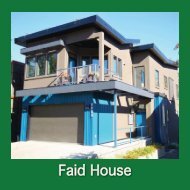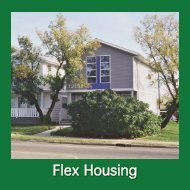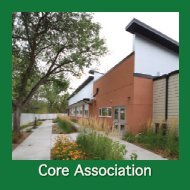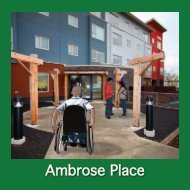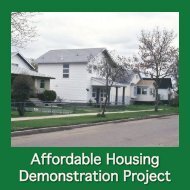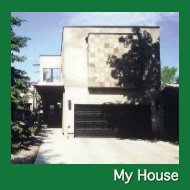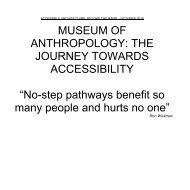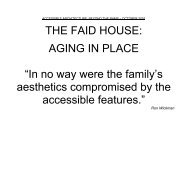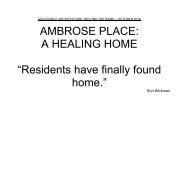Core Association
Project by Ron Wickman Architect
Project by Ron Wickman Architect
You also want an ePaper? Increase the reach of your titles
YUMPU automatically turns print PDFs into web optimized ePapers that Google loves.
ACCESSIBLE ARCHITECTURE: BEYOND THE RAMP – OCTOBER 2016<br />
CORE ASSOCIATION:<br />
HOUSING WITH HEART<br />
“Designing with positive<br />
wayfinding in mind helps<br />
everyone feel safe and<br />
comfortable.”<br />
Ron Wickman<br />
65
ACCESSIBLE ARCHITECTURE: BEYOND THE RAMP – OCTOBER 2016<br />
The above image shows an exterior view of the building.<br />
The design takes advantage of the south-facing valley views. Large skylights bring natural southern<br />
light into the heart of the building. The exterior form and finishing is inspired by modern and rural<br />
architecture. The use of common local materials such as corrugated metal and stucco helps to link<br />
the building to its regional context.<br />
66
ACCESSIBLE ARCHITECTURE: BEYOND THE RAMP – OCTOBER 2016<br />
In early 2011, Clients Ongoing Rehabilitation and Equality (CORE) <strong>Association</strong> hired me to develop<br />
plans for a new innovative home that would allow individuals to age in place by remaining in the<br />
community with familiar caregivers, ensuring a quality of life with the care they need and deserve.<br />
This project involved the conversion of a four-classroom school and gymnasium into an eightbedroom<br />
residential home for people with developmental disabilities and a concurrent diagnosis of<br />
dementia or Alzheimer’s disease.<br />
In 1960, CORE had built the George P. Vanier School in Medicine Hat, Alberta for 15 students. In<br />
the early 1980s, the school became part of the Medicine Hat School District and five years later, it<br />
was closed. Work began on its residence conversion in 2011. The transformation of the George P.<br />
Vanier School into a home for long-term care is based on an age – in - place care - support model<br />
providing the necessary resources for those living with disabilities and complex needs. The entire<br />
facility design is based on accessible living allowing for maximum mobility and independence.<br />
Residents of the new home were born with some form of cognitive limitation, and have later also<br />
developed some form of dementia. The design facilitates care for residents with dementia,<br />
accommodating their special needs such as safety, sufficient illumination, choice of movement, and<br />
a clearly legible circulation system.<br />
67
ACCESSIBLE ARCHITECTURE: BEYOND THE RAMP – OCTOBER 2016<br />
The above drawing shows an interior view of the living and kitchen area of the CORE Care Home.<br />
The circulation systems provide for clear composition of spaces that can be easily perceived. Our<br />
attempt was to create positive and purposeful relationships between indoors and outdoors, light<br />
and dark areas, for loud and peaceful rooms, and allow residents to be on their own or a part of the<br />
larger community.<br />
68
ACCESSIBLE ARCHITECTURE: BEYOND THE RAMP – OCTOBER 2016<br />
The home was designed to provide residents a clear choice for movement, and to respect their<br />
wishes for self-control. The challenge is to design a safe environment, but not in a way that<br />
residents feel that their movement is being controlled or restricted. Persons with dementia can<br />
become agitated when they feel that others control their movement. As most people age they feel<br />
a need for a safe and secure environment, especially those persons with dementia. The<br />
environment was designed to make finding one’s way around easy and to provide a sense of<br />
security, without using schematic signage and wayfinding systems typically seen in hospitals.<br />
The design attempts to address and cater to the needs of the residents and staff, not the conditions<br />
with which the residents live.<br />
The one-story building now houses eight residents with two respite bedrooms available for use by<br />
the community. All ten residences incorporate their own fully accessible bathroom. The gymnasium<br />
was converted into a kitchen and dining area. Other functions in the building include a Crafts Room,<br />
Laundry Room, Therapy Tub Room, Public Washroom, and Office Space. To make all of this work,<br />
additions were completed to the North, West and East sides of the building.<br />
69
ACCESSIBLE ARCHITECTURE: BEYOND THE RAMP – OCTOBER 2016<br />
The above image shows an interior view of a hallway space.<br />
The use of color and textural contrast can be very powerful, Herein, color and textural contrast is<br />
kept to a minimum to minimize too much visual complexity. The lesson here is to minimize visual<br />
stimulation and provide instead more purposeful visual stimulation.<br />
70
ACCESSIBLE ARCHITECTURE: BEYOND THE RAMP – OCTOBER 2016<br />
Indoor spaces have been designed to be communal and to make choice for movement as easy as<br />
possible. Persons with advanced stage dementia tend to walk about in public areas, not in private.<br />
Chance contact with others is deemed as a positive thing.<br />
The main design feature of the project is the walk-about. The circular layout of the hallway allows<br />
individuals to walk around the whole building without getting lost. Large skylight structures were<br />
added to the roof to help bring natural light into the middle of the building and the walk-about. Color<br />
and texture contrast is used strategically to better help residents, staff, and visitors in their<br />
wayfinding.<br />
The kitchen and living area has been designed to be the center of daily life for the residents and<br />
their families and staff. This space is the focus of daily routines and communal life.<br />
All resident bathrooms are designed and constructed as wetrooms. All shower areas are wheelchair<br />
accessible and large enough to accommodate a resident and an attendant. This is Accessible<br />
Architecture where everyone benefits.<br />
71
ACCESSIBLE ARCHITECTURE: BEYOND THE RAMP – OCTOBER 2016<br />
The above drawing shows the landscape plan of CORE Care Home.<br />
The design of the outdoor space at the CORE Care Home offers the same safe, simple, and easy<br />
choice for movement. Easy access to the garden spaces, with familiar native planting to trigger<br />
positive memories and free movement allows residents to savor the pleasure of being outside. The<br />
outside space was designed to provide sensory stimulation that is meaningful, safe and<br />
understandable, as well as to provide for pleasure, socializing, and activity. With the addition of<br />
areas of sun and shade, seating and tables, the outdoor environment helps reduce the residents’<br />
behaviors that challenge and stress. Obviously, this makes life easier for the caregivers as well.<br />
72
ACCESSIBLE ARCHITECTURE: BEYOND THE RAMP – OCTOBER 2016<br />
The above image shows a portion of the exterior south facing walk - about.<br />
When the home environment is designed to be beautiful, everyone benefits. Residents, family, staff,<br />
and visitors can feel part of the environment and also feel valued.<br />
This building owned by CORE has now served as a school and a care home. It is located in a<br />
meaningful location, which plays a major role in the community. In time, when our aging population<br />
decreases, the building could easily be converted back into a school.<br />
73


